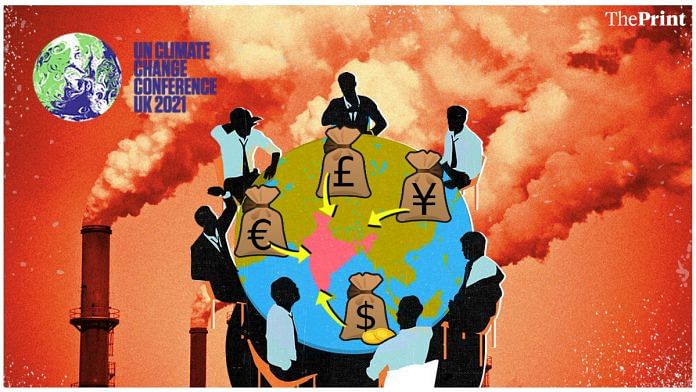The United Nations Climate Change Conference (COP26) meetings in Glasgow from 31 October to 12 November will lay out the commitments various countries make for reducing carbon emissions.
There is pressure on India to declare a target for achieving net zero emissions, but it has rejected these calls. The developed world, including non-government organisations and individuals, needs to financially support India’s efforts to decarbonise and to adapt to the changed climate.
We are used to pollution such as the dust in the air in north India. This is created by human beings, but when it rains, the air is cleansed. Every year, we go through this cycle of dirtying the air of north India, and the rains come along and clean it.
Carbon dioxide is fundamentally different. Once it is put into the air, it lasts for about 1,000 years. The problems of global warming are determined by the stock of CO2 in the air, and not the annual flow. Once we pull fossil fuels out of the ground (coal, gas, oil) and put CO2 in the air, it essentially stays there forever. Conventional mild climate works out at about 150 parts per million of CO2; the human race has got it up to about 400 ppm; and the climate is going to get significantly disrupted in the range of 450 to 500 ppm.
Also read: How COP26 can make up for the failure of 25 previous conferences to tackle climate change
India did not make this problem
Historically, human beings have burned small amounts of coal for a long time. The Industrial Revolution started when James Watt invented the steam engine in 1776, and there was a surge in the burning of coal, led by the UK and Europe, and then the US. In the later years, a large share of global manufacturing moved to China, and China has come up as a large polluter. The bulk of the stock of CO2 in the air has been put there by today’s advanced economies, and by China.
India did not make this problem! Out of the stock of CO2 in the air today, 3 per cent was made in India. On a flow basis, India is making 7 per cent of the CO2 being added into the air every year. Clearly, both these are small shares.
This is the fascinating feature of the global warming puzzle. India is extremely exposed to the ravages of climate change. A recent report on climate vulnerability by CEEW said 80 per cent of the Indian population lives in areas that will be affected by climate change. We cannot be cavalier about this, and it would be a wonderful thing for India if the world’s net CO2 emissions go to roughly zero in the next 20 years. But at the same time, it is a fact that India did not make this problem, and it is not fair that we are being asked to undertake costly actions in order to reduce our emissions.
Rich countries should send resources to India
Fairness demands that today’s advanced countries, and China, who created this problem, should send resources into India to help it achieve its decarbonisation targets, and pay it to adapt to the changing climate.
This process consists of three elements. All three elements need to be nurtured on both the sending and receiving sides.
One element, which tends to dominate media headlines, is official flows. This is aid that comes from rich countries to the Government of India. There is a need for institutional reform through which this resource flow increasingly goes beyond the Union and directly to states and to cities.
The second element is the vast ‘ESG’ (environmental, social and governance) investment flows. First world countries have reshaped the investment environment so that Indian companies seeking debt and equity capital, from the global financial system, have strong incentives to seek decarbonisation. This involves an element of concessional financing, where first world investors are accepting an inferior rate of return as a consequence of their constrained optimisation.
ESG capital moves between private people abroad and private people in India. The weaknesses in Indian financial regulation harm the extent to which global ESG financing can beneficially impact India. The strategy for India to best exploit this situation lies in fundamental financial reform, i.e. the Financial Sector Legislative Reforms Commission (FSLRC) agenda. It will require strong capital account decontrol.
The third element of cross-border resource flows is philanthropy. Rich countries have foundations that gift money to support developing countries in meeting the challenges of climate change. This money will be an increasingly important element of the response to difficulties that arise in India. The country needs to better harness this source of finance through suitable legal and regulatory change.
While India is not making “nationally determined commitments” to net zero emissions at COP26, it is clear that sooner or later, the country will have to move forward on this agenda. This is the time to initiate the legal and regulatory changes that will allow finance from rich countries to flow to various stakeholders in the Indian public and private system and encourage initiatives to decarbonise.
Ila Patnaik is a professor at NIPFP. The book ‘The Rise of the BJP’, by Bhupender Yadav and Ila Patnaik, will be released in December 2021.
Also read: COP26 opportunity to move from words to actions, can’t rely on govt action alone, experts say






